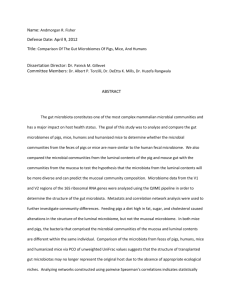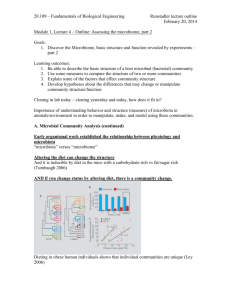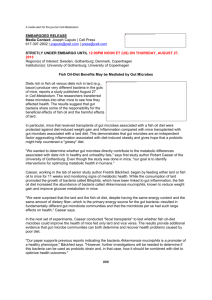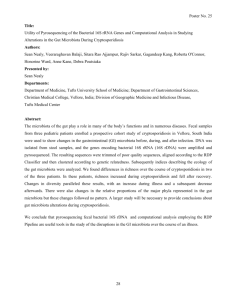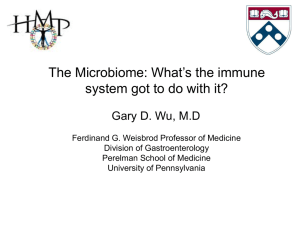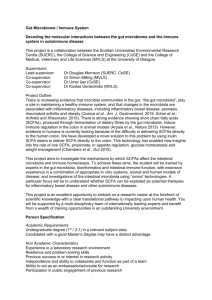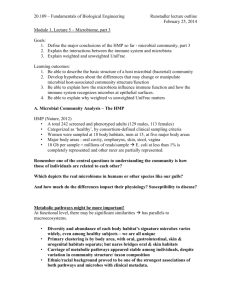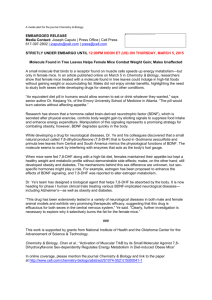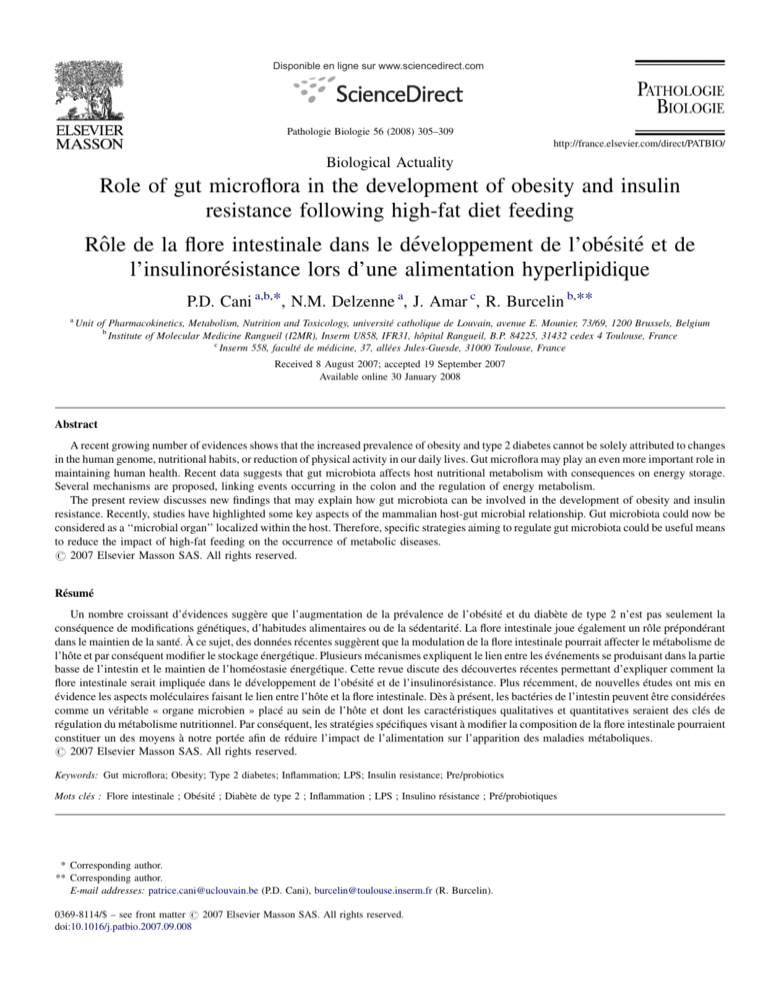
Disponible en ligne sur www.sciencedirect.com
Pathologie Biologie 56 (2008) 305–309
http://france.elsevier.com/direct/PATBIO/
Biological Actuality
Role of gut microflora in the development of obesity and insulin
resistance following high-fat diet feeding
Rôle de la flore intestinale dans le développement de l’obésité et de
l’insulinorésistance lors d’une alimentation hyperlipidique
P.D. Cani a,b,*, N.M. Delzenne a, J. Amar c, R. Burcelin b,**
a
Unit of Pharmacokinetics, Metabolism, Nutrition and Toxicology, université catholique de Louvain, avenue E. Mounier, 73/69, 1200 Brussels, Belgium
b
Institute of Molecular Medicine Rangueil (I2MR), Inserm U858, IFR31, hôpital Rangueil, B.P. 84225, 31432 cedex 4 Toulouse, France
c
Inserm 558, faculté de médicine, 37, allées Jules-Guesde, 31000 Toulouse, France
Received 8 August 2007; accepted 19 September 2007
Available online 30 January 2008
Abstract
A recent growing number of evidences shows that the increased prevalence of obesity and type 2 diabetes cannot be solely attributed to changes
in the human genome, nutritional habits, or reduction of physical activity in our daily lives. Gut microflora may play an even more important role in
maintaining human health. Recent data suggests that gut microbiota affects host nutritional metabolism with consequences on energy storage.
Several mechanisms are proposed, linking events occurring in the colon and the regulation of energy metabolism.
The present review discusses new findings that may explain how gut microbiota can be involved in the development of obesity and insulin
resistance. Recently, studies have highlighted some key aspects of the mammalian host-gut microbial relationship. Gut microbiota could now be
considered as a ‘‘microbial organ’’ localized within the host. Therefore, specific strategies aiming to regulate gut microbiota could be useful means
to reduce the impact of high-fat feeding on the occurrence of metabolic diseases.
# 2007 Elsevier Masson SAS. All rights reserved.
Résumé
Un nombre croissant d’évidences suggère que l’augmentation de la prévalence de l’obésité et du diabète de type 2 n’est pas seulement la
conséquence de modifications génétiques, d’habitudes alimentaires ou de la sédentarité. La flore intestinale joue également un rôle prépondérant
dans le maintien de la santé. À ce sujet, des données récentes suggèrent que la modulation de la flore intestinale pourrait affecter le métabolisme de
l’hôte et par conséquent modifier le stockage énergétique. Plusieurs mécanismes expliquent le lien entre les événements se produisant dans la partie
basse de l’intestin et le maintien de l’homéostasie énergétique. Cette revue discute des découvertes récentes permettant d’expliquer comment la
flore intestinale serait impliquée dans le développement de l’obésité et de l’insulinorésistance. Plus récemment, de nouvelles études ont mis en
évidence les aspects moléculaires faisant le lien entre l’hôte et la flore intestinale. Dès à présent, les bactéries de l’intestin peuvent être considérées
comme un véritable « organe microbien » placé au sein de l’hôte et dont les caractéristiques qualitatives et quantitatives seraient des clés de
régulation du métabolisme nutritionnel. Par conséquent, les stratégies spécifiques visant à modifier la composition de la flore intestinale pourraient
constituer un des moyens à notre portée afin de réduire l’impact de l’alimentation sur l’apparition des maladies métaboliques.
# 2007 Elsevier Masson SAS. All rights reserved.
Keywords: Gut microflora; Obesity; Type 2 diabetes; Inflammation; LPS; Insulin resistance; Pre/probiotics
Mots clés : Flore intestinale ; Obésité ; Diabète de type 2 ; Inflammation ; LPS ; Insulino résistance ; Pré/probiotiques
* Corresponding author.
** Corresponding author.
E-mail addresses: patrice.cani@uclouvain.be (P.D. Cani), burcelin@toulouse.inserm.fr (R. Burcelin).
0369-8114/$ – see front matter # 2007 Elsevier Masson SAS. All rights reserved.
doi:10.1016/j.patbio.2007.09.008
306
P.D. Cani et al. / Pathologie Biologie 56 (2008) 305–309
1. Introduction
Obesity and type 2 diabetes are two metabolic diseases
resulting from a combination in variable association of genetic
and environmental factors [1]. These two metabolic diseases
are characterised by a low grade inflammation associated with
the development of insulin resistance [2,3]. Whereas the impact
of a point mutation, in a key mechanism, could lead to obesity
and type 2 diabetes, the molecular events allowing environmental factors to provoke the same pathological consequences,
are poorly understood.
Nowadays, the growing epidemic of obesity and type 2
diabetes prompts the scientific community to develop or
identify new therapeutic targets. The excessive energy intakes,
as well as the reduction of physical activity, are certainly two
environmental factors classically associated with the development of metabolic diseases. Among these most common
triggering events, a fat-enriched diet generates features of
metabolic disorders leading to the diseases.
Over the last years, numerous attempts have been performed
to determine the triggering factor which (1) would depend on
fat feeding, (2) trigger a low grade inflammation and (3) behave
over a long term period, to be part of the progressive disease.
The aim of this review is to highlight how the modulation of gut
microbiota affects the development of obesity and type 2
diabetes.
2. Gut microbiota and energy metabolism
The intestinal flora has been recently proposed as an
environmental factor involved in the control of body weight and
energy homeostasis [4–9]. The human intestine contains a large
variety of microorganisms, this community consists of at least
1014 bacterial cells and up to 500–1000 different species. As a
whole this represents overall more than 100 times the human
genome [10,11], and is called the ‘‘metagenome’’. Thus, the
intestinal flora can be considered as an ‘‘exteriorized organ’’
which contributes to our homeostasis with multiple functions
largely diversified. The biological functions controlled by the
intestinal flora are related to the effectiveness of energy harvest,
by the bacteria, of the energy ingested but not digested by the
host. Among the dietary compound escaping to the digestion
occurring in the upper part of the human gastro-intestinal tract,
the polysaccharides constitute the major source of nutrient for
the bacteria. Part of these polysaccharides could be transformed
into digestible substances such as sugars, or short chain
carboxylic acids, providing energy substrates which can be
used by the bacteria or the host. The control of body weight
depends on mechanisms subtly controlled over time and a small
daily excess, as low as 1% of the daily energy needs, can have
important consequences in the long term on body weight and
metabolism [12]. Consequently, all mechanisms modifying the
food-derived energy availability should contribute to the
balance of the body weight. Several studies from the group
of Gordon [4,5] highlighted that the gut microbiota of obese
subjects changed according to the loss of body weight occurring
after a hypocaloric diet. The authors demonstrated that two
groups of bacteria are dominant in the intestinal tract,
Bacteroidetes and Firmicutes [4]. The quantification and
characterization of each dominant group of bacteria were
carried out by measuring the concentration of the bacterial 16S
rRNA. The authors show that the number of Bacteroidetes
bacteria depended on the weight loss whereas the Firmicutes
bacteria group remained unchanged. Importantly, the bacterial
lineage was constant one year after the dietary intervention for a
given body weight, validating the bacterial signature of each
individual. The specificity of these differences between
individual and body weight is not explained. However, it
could be related to the diet and in particular to the presence of
dietary fibres [13–16] (Cani et al. Personal Communication).
Gordon and colleagues [4,5] propose that the gut bacteria from
obese subjects are able to specifically increase the energy
harvested from the diet, which provide an extra energy to the
host. This conclusion was drawn from work showing that the
axenic mice colonized with a conventional gut flora gain weight
rapidly. Indeed, axenic mice bearing the same age and genetic
background than the conventional mice exhibit a 40% lower
weight [8]. In the same line, the authors demonstrated that
axenic mice colonized with the gut microflora derived from the
conventional mice increased their fat mass by about 60% and
developed insulin resistance within two weeks. The mechanisms of the apparent gain weight implied an increase in the
intestinal glucose absorption, energy extraction from nondigestible food component (short chain fatty acids produced
through the fermentation) and a concomitant higher glycemia
and insulinemia, two key metabolic factors promoting
lipogenesis. These set of experiments demonstrated for the
first time that an environmental factor such as gut microbiota
regulates energy storage. The results, obtained both in rodents
and human, suggest that obesity is associated with an altered
composition of gut microbiota. However, this study did not
demonstrate that the relative change in bacterial strains profile
leads to different fates of body weight gain. To test this
hypothesis, the same group performed experiments were the gut
microbiota from ob/ob was transferred to lean axenic mice.
They found that after only two weeks, lean mice colonized with
the microbiota from obese mice had a modest fat gain. Such
mice extracted more energy from their food as compared to the
mice colonized with the gut microbiota from lean mice [5].
Together, these data suggest that the differences between both
groups of lean mice, in term of fat and body weight gain, might
be attributable to change in gut microbiota.
This particularly original idea that the bacteria can
contribute to the maintenance of the host body weight, is
characterized by numerous paradoxes. It is not clear, however,
whether the small increased of energy extraction can actually
contribute to a meaningful body weight gain within a short
period of time, as suggested in the gut flora transplantation
studies. Moreover, we and other have clearly shown that a diet
rich in non-digestible fibres decreases body weight, fat mass
and the severity of diabetes [17–21]. However these dietary
fibres increase strains of bacteria able to digest these fibres and
provide extra-energy for the host as they thus increase the total
amount of bacteria in the colon [13,22,23]. This mechanism is
P.D. Cani et al. / Pathologie Biologie 56 (2008) 305–309
not completely in accordance with the ‘‘energy harvesting
theory’’ according to which the fermentation of non digestible
polysaccharides would provide energy substrates for the host.
In addition, it is difficult to conclude that small changes in
energy ingestion (1–2%) can induce sufficient quick variation
in weight (within two weeks) as observed in the American
studies [5–8]. Importantly, the axenic mice colonized with the
gut flora from normal mice ate more than their conventional
mice counterparts; therefore, the body weight gain can also be
dependent of the increased food intake. A last crucial point,
which cannot depend only on the role played by the bacteria to
harvest energy from nutrients escaping digestion in the upper
part of the intestine, concerns a study showing that axenic mice
are more resistant to diet-induced obesity [6]. The authors
maintained axenic or conventionalized mice on a high-fat/highcarbohydrates diet (western diet) and found that conventionalized animals fed the western diet gained significantly more
weight and fat mass and had higher glycemia and insulinemia
than the axenic mice. Strikingly, and opposite to the results
previously observed in axenic mice fed a normal chow diet, the
amount of western diet taken up by an axenic or a
conventionalized mouse was similar and hence had similar
fecal energy output. All those data suggest that a bacterially
related factor is responsible for the development of dietinduced obesity and diabetes.
Another point remains to be elucidated, how can we attribute
the low grade inflammatory process observed during metabolic
diseases to the energy harvested from the gut bacteria?
3. Gut microbiota and inflammation
Obesity and type 2 diabetes are metabolic diseased
characterized by a low grade inflammation [3]. In the models
of high fat diet induced obesity, adipose depots express several
inflammatory factors IL-1, TNF-a and IL-6 [24,25]. These
cytokines impaired insulin action and induce insulin resistance.
For example, TNF-a phosphorylates serine residue substrate
(IRS-1) from the insulin receptor leading its inactivation [26].
Recently, it has been proposed that nutritional fatty acids trigger
inflammatory response by acting via the toll-like receptor-4
(TLR4) signalling in the adipocytes and macrophages. The
authors shown that the capacity of fatty acids to induce
inflammatory signalling following a high-fat diet feeding is
blunted in the TLR4 knock out mice [27]. Altough TLR4 is the
coreceptor for the lipopolysaccharides (LPS) constituent of the
Gram negative bacteria, the authors did not characterise the gut
microbiota following high fat diet feeding. Therefore, we have
been looking for a triggering factor of the early development of
metabolic diseases, we looked for a molecule involved early in
the cascade of inflammation and identified that LPS as a
good candidate [28]. Furthermore, LPS is a strong inducer of
inflammatory response and is involved in the release of several
cytokines that are key factors triggering insulin resistance. The
concept of dietary excess is more ore less associated to high-fat
feeding-induced inflammation. As we identified recently LPS
as a putative factor for the triggering of obesity and insulin
resistance, we challenge our hypothesis in a pathological
307
context (obesity and insulin resistance) of high-fat diet fed
mice. Mice fed a high-fat diet for a short term period as two to
four weeks exhibit a significant increase in plasma LPS. An
endotoxemia that we characterized as a ‘‘metabolic endotoxemia’’, since, the LPS plasma concentrations were 10 to 50
times lower than those obtained during a septic shock [29]. The
mechanisms allowing LPS absorption are not clear but could be
related to an increased absorption during fat digestion [30]. LPS
is absorbed into intestinal capillaries to be transported by
lipoproteins (i.e. chylomicrons) [31–33]. We then demonstrated
that high-fat diet feeding changed gut microbiota in favour of
an increase in the Gram negative to Gram positive ratio. Indeed,
the number of Bifidibacterium spp. and E. rectale/Cl. coccoides
group were reduced, the first group of bacteria has been shown
to reduce intestinal endotoxin levels in rodents and improve
mucosal barrier function [34–36]. In order to determine the role
of metabolic endotoxemia in the development of metabolic
disorders such as diabetes and obesity, we mimicked the
metabolic endotoxemia by chronically infusing a low dose of
LPS to reach the same plasma LPS levels as the one measured
in the high-fat diet fed mice. The four weeks chronic low dose
LPS infusion mimicked the high-fat diet fed mice phenotype
with a fasted hyperglycemia, obesity, steatosis, adipose tissue
macrophages infiltration, hepatic insulin resistance and hyperinsulinemia. To demonstrate our hypothesis that the metabolic
endotoxemia is a triggering factor in the development of
metabolic diseases, we challenged LPS receptor knock out
mice (CD14 knock out mice-CD14KO) with a high-fat diet and
a chronic low dose LPS infusion. CD14 is a key molecule
involved in the innate immune system [37]. CD14 is a
multifunctional receptor constituted by a phosphatidyl inositol
phosphate-anchored glycoprotein of 55 kDa expressed on the
surface of monocytes, macrophages and neutrophils [38–41].
We have shown that CD14KO mice were hypersensitive to
insulin even when fed a normal diet, suggesting that CD14
could be modulator of insulin sensitivity in physiological
conditions. As a matter of fact, CD14KO mice resist high-fat
diet and chronic LPS-induced metabolic disorders. Similarly
hepatic steatosis, liver and adipose tissue inflammation and
adipose tissue macrophages infiltration was totally blunted in
the CD14KO mice fed a high-fat diet or infused with LPS [28].
In these sets of experiments, we showed that high-fat feeding
induced a low tone inflammation which originates from the
intestinal absorption of the LPS.
Thus altogether our data support the key idea that the gut
microbiota can contribute to the pathophysiology of obesity and
type 2 diabetes. We report that high-fat feeding alters the
intestinal microbiota composition were Bifidobacterium spp
were reduced. Several studies have shown that this specific
group of bacteria reduced the intestinal endotoxin levels and
improved mucosal barrier function [34–36], therefore, in a
recent study we addressed this question: Could the selective
increase of bifidobacteria in gut microflora improves high-fat
diet-induced diabetes in mice?
We used the unique advantage of the prebiotic dietary fibres
(oligofructose, [OFS]) [15] to specifically increase the gut
bifidobacteria content of high-fat diet treated mice. We found
308
P.D. Cani et al. / Pathologie Biologie 56 (2008) 305–309
that among the different gut bacteria analysed, plasma LPS
concentrations correlated negatively with Bifidobacterium spp
[42]. We confirm that mice fed a high-fat diet exhibit a higher
endotoxemia a phenomenon completely abolished in the
prebiotic dietary fibres fed mice. We found that in the prebiotic
treated-mice, Bifidobacterium spp. significantly and positively
correlated with improved glucose-tolerance, glucose-induced
insulin-secretion, and normalized inflammatory tone (decreased endotoxemia, plasma and adipose tissue pro-inflammatory
cytokines) [42]. Together, these findings suggest that the gut
microbiota contributes to the pathophysiological regulation of
endotoxemia, and sets the tone of inflammation for the
occurrence of diabetes/obesity. Thus, it would be useful to
develop specific strategies for modifying gut microbiota to
favour bifidobacteria growth and prevent the deleterious effect
of high-fat diet-induced metabolic diseases.
4. Conclusion
The demonstration of the role of gut microflora in maintaining
human health led the scientific community to consider the means
by which the gut microflora could be manipulated. Different and
complementary mechanisms can be proposed to explain the
metabolic shift towards energy storage. The first described
mechanism consists in the role of the gut microbiota to increase
the capacity to harvest energy from the diet. The second one
consists in the role of the gut microbiota to modulate plasma LPS
levels which triggers the inflammatory tone and the onset of
obesity and type 2 diabetes. Nevertheless, a number of questions
remain: how and why the composition of gut microbiota may be
associated with obesity and other nutritional disorders? How the
specific modulation of bifidobacteria lowers plasma LPS levels
and metabolic consequences? Can we propose specific strategies
for modifying gut microbiota (in favour of i.e. bifidobacteria?) to
reduce the impact of high fat feeding on the occurrence of
metabolic diseases in humans? Thus, specific strategies for
modifying gut microbiota would be useful tools to reduce the
impact of high-fat feeding on the occurrence of metabolic
diseases.
References
[1] Kahn SE, Hull RL, Utzschneider KM. Mechanisms linking obesity to
insulin resistance and type 2 diabetes. Nature Dec 14, 2006;444(7121):
840–6.
[2] Hotamisligil GS. Inflammation and metabolic disorders. Nature Dec 14,
2006;444(7121):860–7.
[3] Wellen KE, Hotamisligil GS. Inflammation, stress, and diabetes. J Clin
Invest May, 2005;115(5):1111–9.
[4] Ley RE, Turnbaugh PJ, Klein S, Gordon JI. Microbial ecology: human gut
microbes associated with obesity. Nature Dec, 2006;21444(7122):1022–3.
[5] Turnbaugh PJ, Ley RE, Mahowald MA, Magrini V, Mardis ER, Gordon JI.
An obesity-associated gut microbiome with increased capacity for energy
harvest. Nature Dec 21, 2006;444(7122):1027–31.
[6] Backhed F, Manchester JK, Semenkovich CF, Gordon JI. Mechanisms
underlying the resistance to diet-induced obesity in germ-free mice. Proc
Natl Acad Sci U S A Jan 16, 2007;104(3):979–84.
[7] Backhed F, Ley RE, Sonnenburg JL, Peterson DA, Gordon JI. Host-bacterial
mutualism in the human intestine. Science Mar 25, 2005;307(5717):
1915–20.
[8] Backhed F, Ding H, Wang T, Hooper LV, Koh GY, Nagy A, et al. The gut
microbiota as an environmental factor that regulates fat storage. Proc Natl
Acad Sci U S A Nov 2, 2004;101(44):15718–23.
[9] Ley RE, Backhed F, Turnbaugh P, Lozupone CA, Knight RD, Gordon JI.
Obesity alters gut microbial ecology. Proc Natl Acad Sci U S A Aug 2,
2005;102(31):11070–5.
[10] Xu J, Mahowald MA, Ley RE, Lozupone CA, Hamady M, Martens EC,
et al. Evolution of Symbiotic Bacteria in the Distal Human Intestine. PLoS
Biol Jun 19, 2007;5(7):e156.
[11] Xu J, Gordon JI. Inaugural Article: Honor thy symbionts. Proc Natl Acad
Sci U S A Sep 2, 2003;100(18):10452–9.
[12] Hill JO. Understanding and addressing the epidemic of obesity: an energy
balance perspective. Endocr Rev Dec, 2006;27(7):750–61.
[13] Kleessen B, Hartmann L, Blaut M. Oligofructose and long-chain inulin:
influence on the gut microbial ecology of rats associated with a human
faecal flora. Br J Nutr 2001;86(2):291–300.
[14] Kruse HP, Kleessen B, Blaut M. Effects of inulin on faecal bifidobacteria
in human subjects. Br J Nutr Nov, 1999;82(5):375–82.
[15] Tuohy KM, Rouzaud GC, Bruck WM, Gibson GR. Modulation of the
human gut microflora towards improved health using prebiotics–assessment of efficacy. Curr Pharm Des 2005;11(1):75–90.
[16] Tzortzis G, Goulas AK, Gee JM, Gibson GR. A novel galactooligosaccharide mixture increases the bifidobacterial population numbers in a
continuous in vitro fermentation system and in the proximal colonic
contents of pigs in vivo. J Nutr Jul, 2005;135(7):1726–31.
[17] Cani PD, Dewever C, Delzenne NM. Inulin-type fructans modulate
gastrointestinal peptides involved in appetite regulation (glucagon-like
peptide-1 and ghrelin) in rats. Br J Nutr Sep, 2004;92(3):521–6.
[18] Cani PD, Neyrinck AM, Maton N, Delzenne NM. Oligofructose promotes
satiety in rats fed a high-fat diet: involvement of glucagon-like Peptide-1.
Obes Res Jun, 2005;13(6):1000–7.
[19] Cani PD, Daubioul CA, Reusens B, Remacle C, Catillon G, Delzenne NM.
Involvement of endogenous glucagon-like peptide-1(7–36) amide on
glycaemia-lowering effect of oligofructose in streptozotocin-treated rats.
J Endocrinol Jun, 2005;185(3):457–65.
[20] Cani PD, Knauf C, Iglesias MA, Drucker DJ, Delzenne NM, Burcelin R.
Improvement of glucose tolerance and hepatic insulin sensitivity by
oligofructose requires a functional glucagon-like peptide 1 receptor.
Diabetes May, 2006;55(5):1484–90.
[21] Cani PD, Joly E, Horsmans Y, Delzenne NM. Oligofructose promotes
satiety in healthy human: a pilot study. Eur J Clin Nutr May, 2006;60(5):
567–72.
[22] Kolida S, Meyer D, Gibson GR. A double-blind placebo-controlled study
to establish the bifidogenic dose of inulin in healthy humans. Eur J Clin
Nutr Jan 31, 2007.
[23] Kolida S, Saulnier DM, Gibson GR. Gastrointestinal microflora: probiotics. Adv Appl Microbiol 2006;59:187–219.
[24] Hotamisligil GS, Shargill NS, Spiegelman BM. Adipose expression of
tumor necrosis factor-alpha: direct role in obesity-linked insulin resistance. Science Jan 1, 1993;259(5091):87–91.
[25] Weisberg SP, McCann D, Desai M, Rosenbaum M, Leibel RL,
Ferrante Jr AW. Obesity is associated with macrophage accumulation
in adipose tissue. J Clin Invest Dec, 2003;112(12):1796–808.
[26] Hotamisligil GS, Peraldi P, Budavari A, Ellis R, White MF, Spiegelman
BM. IRS-1-mediated inhibition of insulin receptor tyrosine kinase activity
in TNF-alpha- and obesity-induced insulin resistance. Science Feb 2,
1996;271(5249):665–8.
[27] Shi H, Kokoeva MV, Inouye K, Tzameli I, Yin H, Flier JS. TLR4 links
innate immunity and fatty acid-induced insulin resistance. J Clin Invest
Nov, 2006;116(11):3015–25.
[28] Cani PD, Amar J, Iglesias MA, Poggi M, Knauf C, Bastelica D, et al.
Metabolic endotoxemia initiates obesity and insulin resistance. Diabetes
Jul, 2007;56(7):1761–72.
[29] Mitaka C. Clinical laboratory differentiation of infectious versus noninfectious systemic inflammatory response syndrome. Clin Chim Acta
Jan, 2005;351(1–2):17–29.
[30] Black DD, Tso P, Weidman S, Sabesin SM. Intestinal lipoproteins in the rat
with D-(+)-galactosamine hepatitis. J Lipid Res Aug, 1983;24(8):977–92.
P.D. Cani et al. / Pathologie Biologie 56 (2008) 305–309
[31] Tomita M, Ohkubo R, Hayashi M. Lipopolysaccharide transport system
across colonic epithelial cells in normal and infective rat. Drug Metab
Pharmacokinet Feb, 2004;19(1):33–40.
[32] Moore FA, Moore EE, Poggetti R, McAnena OJ, Peterson VM, Abernathy
CM, et al. Gut bacterial translocation via the portal vein: a clinical
perspective with major torso trauma. J Trauma May, 1991;31(5):629–36.
[33] Vreugdenhil AC, Rousseau CH, Hartung T, Greve JW, van’ V, Buurman
WA. Lipopolysaccharide (LPS)-binding protein mediates LPS detoxification by chylomicrons. J Immunol Feb 1, 2003;170(3):1399–405.
[34] Griffiths EA, Duffy LC, Schanbacher FL, Qiao H, Dryja D, Leavens A,
et al. In vivo effects of bifidobacteria and lactoferrin on gut endotoxin
concentration and mucosal immunity in Balb/c mice. Dig Dis Sci Apr,
2004;49(4):579–89.
[35] Wang Z, Xiao G, Yao Y, Guo S, Lu K, Sheng Z. The role of bifidobacteria
in gut barrier function after thermal injury in rats. J Trauma Sep, 2006;
61(3):650–7.
[36] Wang ZT, Yao YM, Xiao GX, Sheng ZY. Risk factors of development of
gut-derived bacterial translocation in thermally injured rats. World J
Gastroenterol Jun, 1 2004;10(11):1619–24.
309
[37] Kitchens RL, Thompson PA. Modulatory effects of sCD14 and LBP on
LPS-host cell interactions. J Endotoxin Res 2005;11(4):225–9.
[38] Haziot A, Ferrero E, Kontgen F, Hijiya N, Yamamoto S, Silver J, et al.
Resistance to endotoxin shock and reduced dissemination of gram-negative bacteria in CD14-deficient mice. Immunity Apr, 1996;4(4):407–14.
[39] Haziot A, Ferrero E, Lin XY, Stewart CL, Goyert SM. CD14-deficient
mice are exquisitely insensitive to the effects of LPS. Prog Clin Biol Res
1995;392:349–51.
[40] Goyert SM, Ferrero E, Rettig WJ, Yenamandra AK, Obata F, Le Beau
MM. The CD14 monocyte differentiation antigen maps to a region
encoding growth factors and receptors. Science Jan 29, 1988;
239(4839):497–500.
[41] Haziot A, Chen S, Ferrero E, Low MG, Silber R, Goyert SM. The
monocyte differentiation antigen, CD14, is anchored to the cell membrane
by a phosphatidylinositol linkage. J Immunol Jul 15, 1988;141(2):547–52.
[42] Cani PD, Neyrinck AM, Fava F, Knauf K, Burcelin RG, Tuohy KM, et al.
Selective increases of bifidobacteria in gut microflora improves high-fat
diet-induced diabetes in mice through a mechanism associated with
endotoxemia. Diabetologia 2007;50(11):2374–83.

